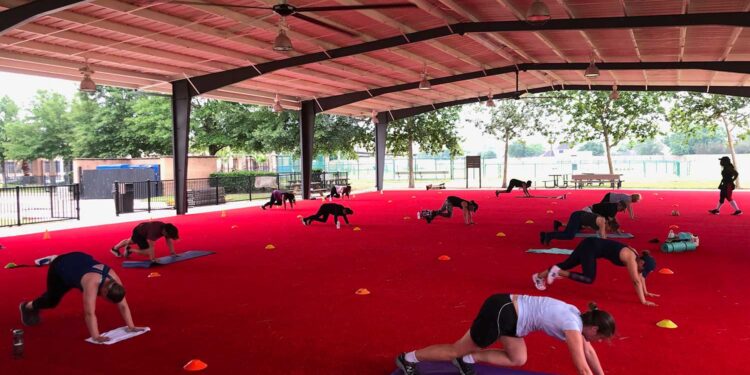Arguably the most prominent challenge community rec centers have faced during the reopening process has been enforcing social distancing guidelines. This challenge is especially difficult to overcome in fitness classes, where participants are in close proximity, breathing heavily in an enclosed space.
The YMCA of Greater Houston, with 32 locations in the Houston, Texas area, found a creative way to overcome that challenge. Partnering with facility design company Gro-Development, the Houston Y repurposed its outdoor pavilions into group exercise spaces that allow for social distancing during classes.
“For the past year, we’ve been looking at how we might use our day camp pavilions more effectively and create value for our members all year long,” said Brian Kridler, the executive vice president of innovation and strategy at the Houston Y. “Obviously, the onset of the coronavirus lent new urgency to that plan. Our immediate instinct was to move toward outdoor exercise and program opportunities because we believed it would be a safer option, and it has been well received by our members.”
Being able to balance physical distancing with social workouts has been critical for the Houston Y. “A YMCA is all about having community, and coming together with a common goal of exercise and social collaboration, but we don’t have to do it in a building,” said Brian Rigby, the director of design at Gro-Development. “They can do it in a park or other setting that gives the opportunity to gather and be healthy.”
Originally intended for day camp and youth programming purposes, most of the Houston Y’s pavilions sat unused the majority of the day. With some guidance from Gro-Development, the Houston Y covered the pavilion floor with red turf and used Aire Fitness® portable fitness studios to outfit the spaces with functional fitness equipment.
“These air studios are eight by 40-foot shipping containers with big barn-style doors, and inside, there are racks with dumbbells, kettlebells, heavy ropes and medicine balls,” said Rigby. “It allows the Y to deliver good functional training classes.”
The change has gone over very well with members. Even if it’s hot outside — as it often is in Texas — participation in group classes has still been fairly steady.
“Having a roof overhead provides some good relief from the sun, and our large ceiling fans help provide increased circulation,” said Kridler. “We also have intentionally been scheduling activities in the morning and later afternoon hours to reduce any risk of heat exhaustion.”
In a time of heightened uncertainty, giving members a sense of normalcy is important for their physical and mental well-being. For the Houston Y, that meant adapting to keep delivering group exercise classes — for another facility, it could mean using an unused space to deliver another popular program.
“Our members see this as a safe alternative, supported by all we have learned about the coronavirus since March,” said Kridler. “We’re able to safely social distance and provide programs for more people in an 8,000-square-foot open air space than a 3,000-square-foot fitness studio.”
Bobby is the former editor of Community Rec Magazine.










